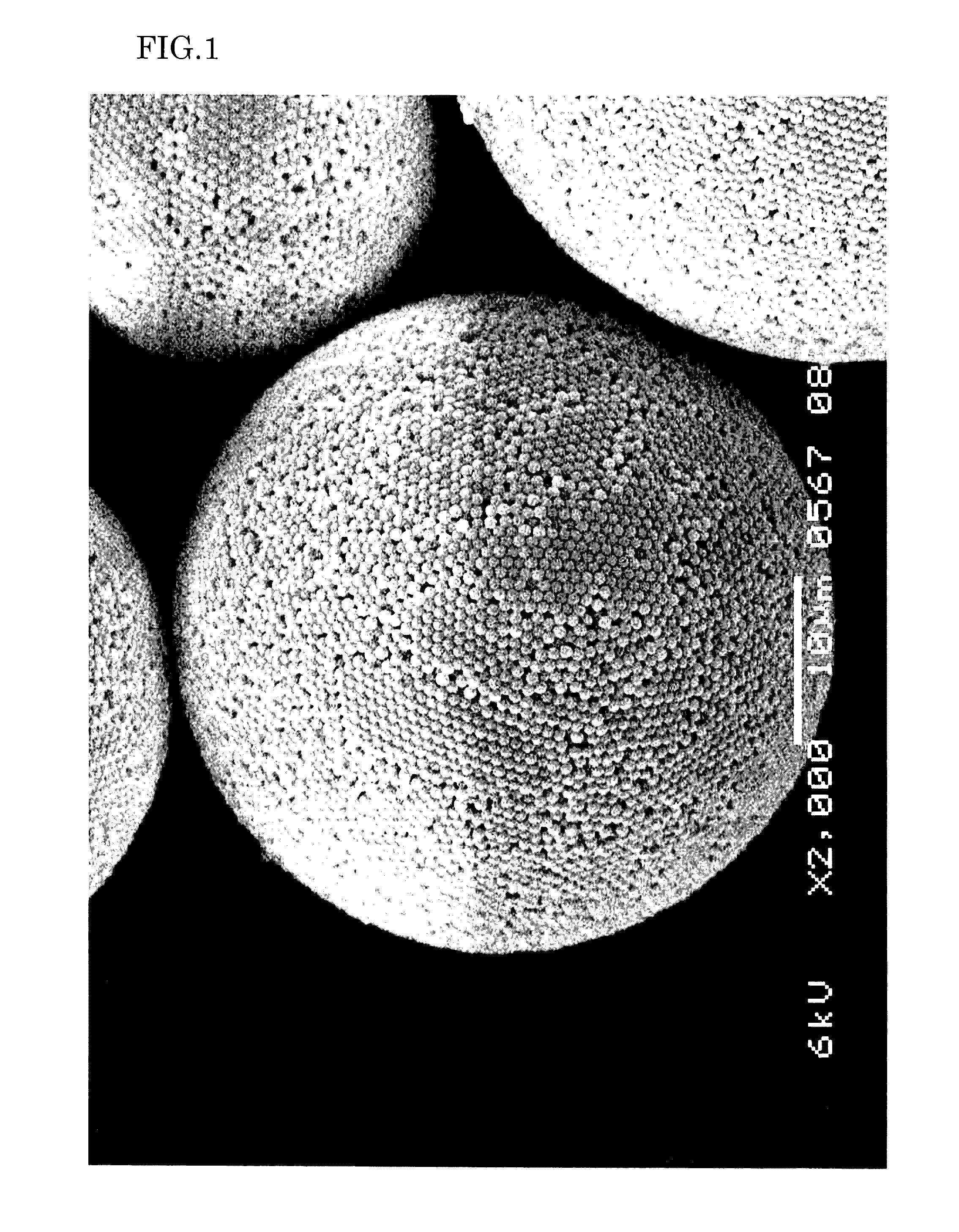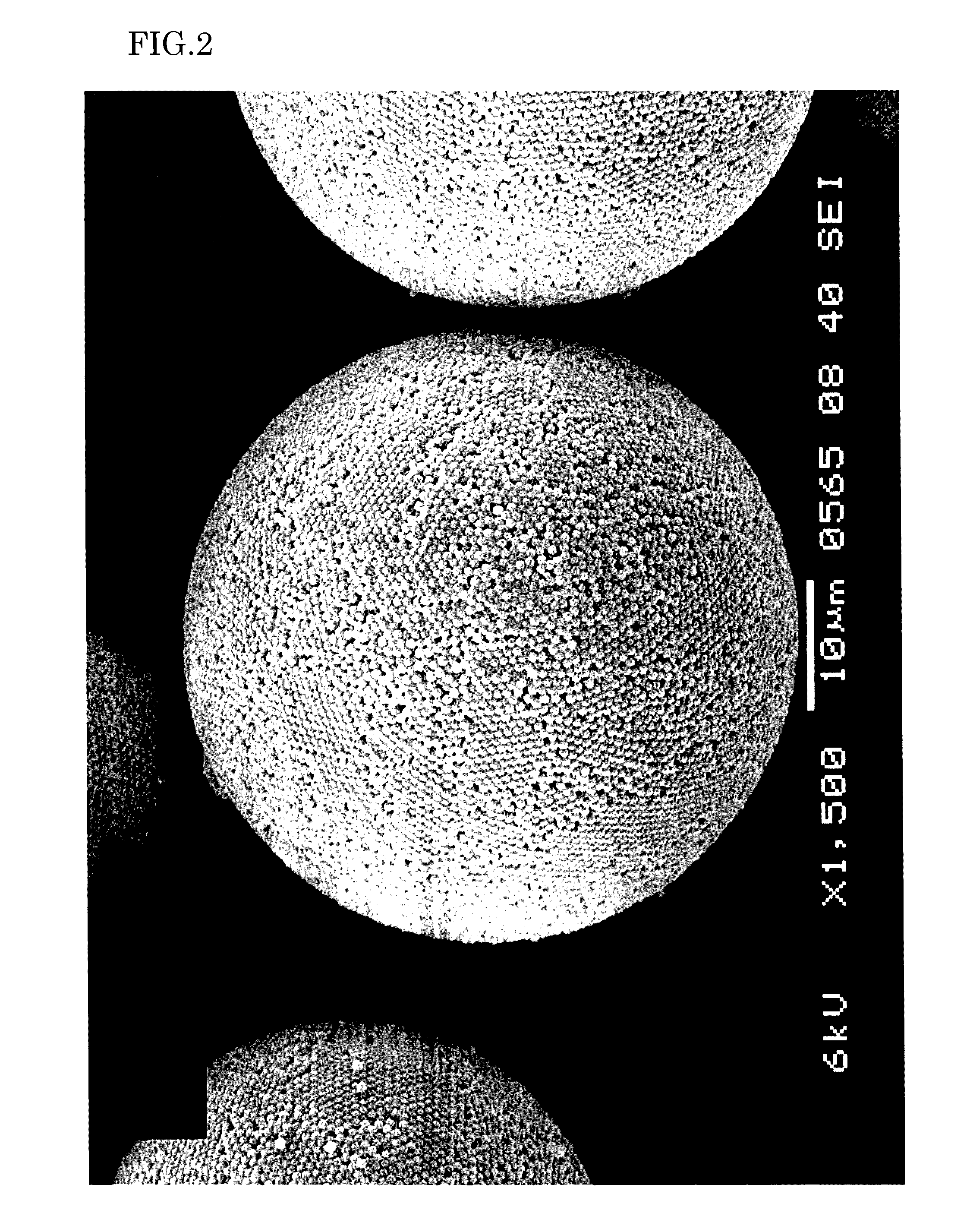Resin particle aggregate, method for manufacturing same and application of same
a technology of resin and aggregate, applied in the direction of coatings, etc., can solve the problems of poor flowability, difficult handling, small particle diameter of resin particles, etc., and achieve good light diffusion properties and optical transparency
- Summary
- Abstract
- Description
- Claims
- Application Information
AI Technical Summary
Benefits of technology
Problems solved by technology
Method used
Image
Examples
example 1
Production of Seed Particles
[0140]First, 250 g of methyl methacrylate as a monofunctional vinyl monomer (first vinyl monomer) and 5 g of n-octyl mercaptan as a chain transfer agent were mixed to give 255 g of a monomer mixture. Separately, 1.5 g of potassium persulfate as a polymerization initiator was dissolved in 18.5 g of deionized water as an aqueous medium to give 20 g of an aqueous potassium persulfate solution.
[0141]Next, in a polymerization vessel equipped with a stirrer and a thermometer, 1,000 g of deionized water as an aqueous medium was placed, and 255 g of the monomer mixture was fed to the polymerization vessel. Subsequently, while the contents in the polymerization vessel were stirred with the stirrer, air in the polymerization vessel was replaced with nitrogen, and the temperature in the polymerization vessel was raised to 70° C. While the stirring was further continued and the temperature in the polymerization vessel was kept at 70° C., 20 g of the aqueous potassium...
example 2
Production of Seed Particles
[0155]The seed particles produced in Example 1 were used.
[0156](Production of Resin Particles)
[0157]First, 6 g of dioctyl sodium sulfosuccinate as a surfactant was dissolved in 894 g of deionized water as an aqueous medium to give 900 g of an aqueous surfactant solution. Separately, 180 g of n-butyl acrylate as a monofunctional vinyl monomer (second vinyl monomer), 120 g of ethylene glycol dimethacrylate (38% by mass relative to the total mass of the resin particles) as a cross-linkable monomer (second vinyl monomer), 3 g of n-dodecyl mercaptan as a chain transfer agent, and 2 g of 2,2′-azobisisobutyronitrile as a polymerization initiator were mixed to give 305 g of a monomer mixed solution.
[0158]Next, in a polymerization vessel equipped with a stirrer and a thermometer, 900 g of the aqueous surfactant solution was placed, and then 305 g of the monomer mixed solution was placed in the polymerization vessel. The contents in the polymerization vessel were t...
example 3
Production of Seed Particles
[0168]First, 250 g of styrene as a monofunctional vinyl monomer (first vinyl monomer) and 5 g of α-methylstyrene dimer as a chain transfer agent were mixed to give 255 g of a monomer mixture. Separately, 1.5 g of potassium persulfate as a polymerization initiator was dissolved in 18.5 g of deionized water as an aqueous medium to give 20 g of an aqueous potassium persulfate solution.
[0169]Next, in a polymerization vessel equipped with a stirrer and a thermometer, 1,000 g of deionized water as an aqueous medium was placed, and 255 g of the monomer mixture was fed to the polymerization vessel. Subsequently, while the contents in the polymerization vessel were stirred with the stirrer, air in the polymerization vessel was replaced with nitrogen, and the temperature in the polymerization vessel was raised to 70° C. While the stirring was further continued and the temperature in the polymerization vessel was kept at 70° C., 20 g of the aqueous potassium persulf...
PUM
| Property | Measurement | Unit |
|---|---|---|
| frequency | aaaaa | aaaaa |
| particle diameter | aaaaa | aaaaa |
| temperature | aaaaa | aaaaa |
Abstract
Description
Claims
Application Information
 Login to View More
Login to View More - R&D
- Intellectual Property
- Life Sciences
- Materials
- Tech Scout
- Unparalleled Data Quality
- Higher Quality Content
- 60% Fewer Hallucinations
Browse by: Latest US Patents, China's latest patents, Technical Efficacy Thesaurus, Application Domain, Technology Topic, Popular Technical Reports.
© 2025 PatSnap. All rights reserved.Legal|Privacy policy|Modern Slavery Act Transparency Statement|Sitemap|About US| Contact US: help@patsnap.com


